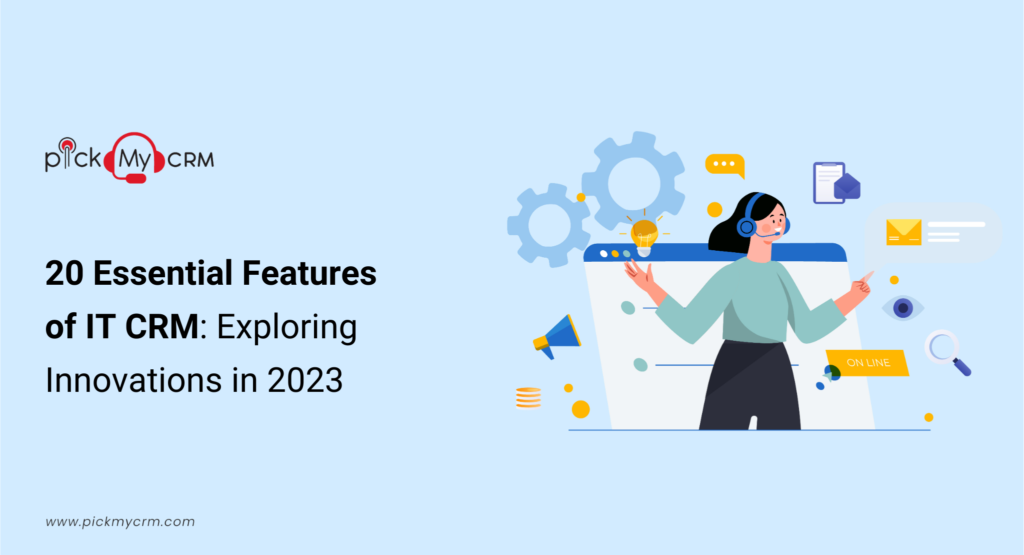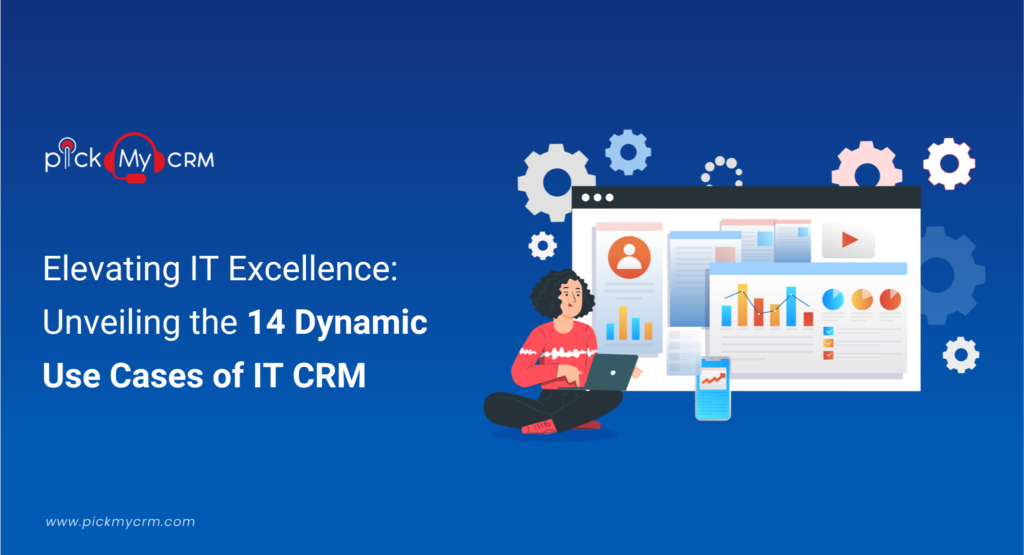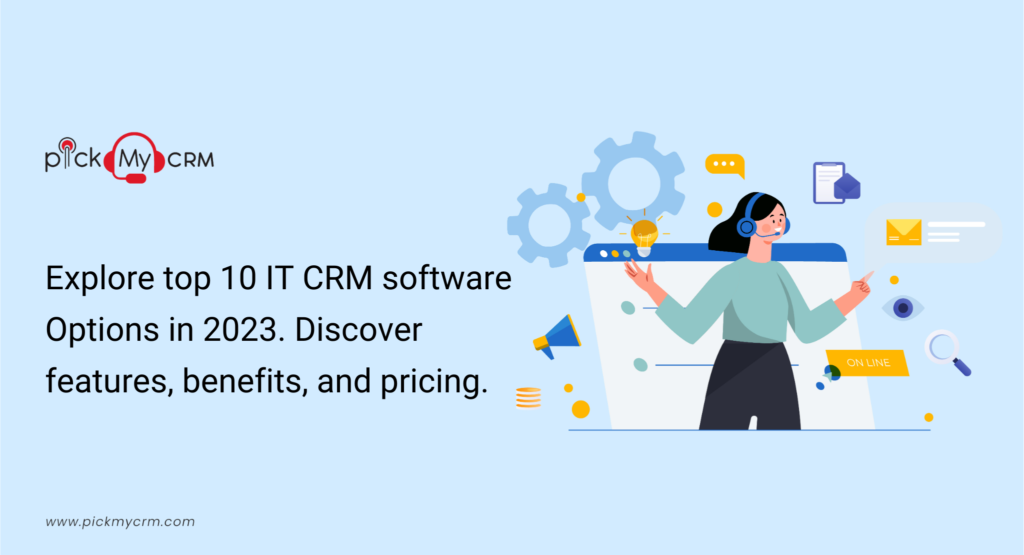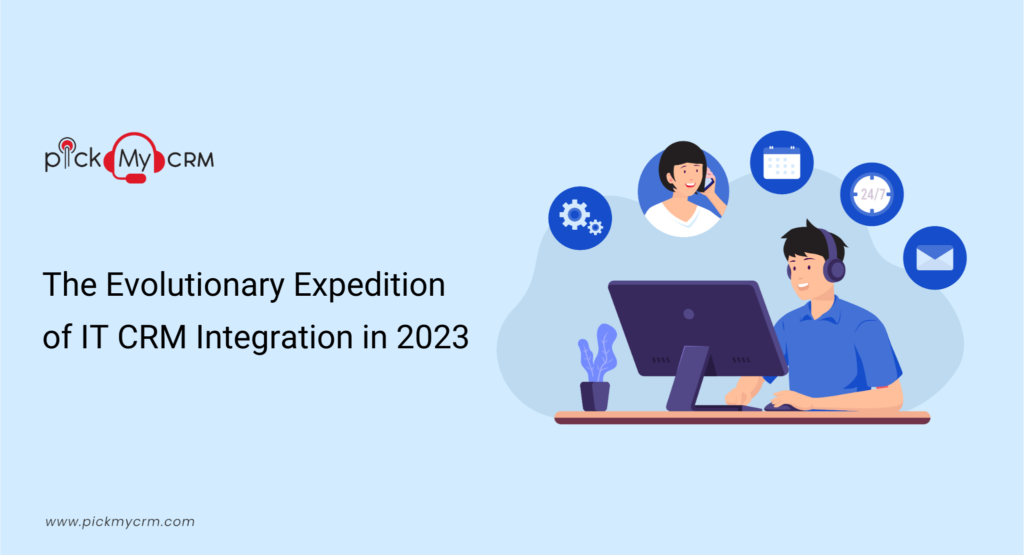20 Essential Features of IT CRM: Exploring Innovations in 2023

What Makes IT CRM Essential
Within the domain of IT, CRM systems serve as the nucleus of customer-centric operations. These platforms consolidate data, enabling businesses to gain holistic insights into customer behavior, preferences, and pain points. With AI-driven analytics and predictive modeling, CRM empowers IT companies to tailor products and services to individual needs, fostering customer loyalty and retention.Why IT CRM is a Game-Changer?
As the calendar turns to 2023, the Arena of IT enterprises finds itself in heightened competition, where personalized customer experiences have emerged as a crucial distinguishing factor. Beyond Its role in handling customer queries and concerns, CRM Plays a pivotal role in enabling IT companies to foresee market trends, thereby contributing to strategic decision-making. By cultivating strong client relationships, CRM becomes a catalyst for revenue growth, as evidenced by a notable 41% upsurge in sales productivity following the adoption of CRM solutions.20 Essential Features of IT CRM in 2023
In the ever-evolving realm of Information Technology (IT), the emergence of Customer Relationship Management (CRM) systems signifies more than just operational streamlining – they also excel in elevating customer engagement. Let's explore the pivotal features that establish CRM as a vital asset for IT enterprises,Features of a 360-degree Customer View with IT CRM
A 360-degree customer view is a Comprehensive, Holistic approach to gathering and analyzing customer data from various touchpoints, enabling businesses to gain deep insights and enhance customer relationships. Definition: A 360-degree customer view is a holistic approach to gathering and analyzing customer data from all touchpoints to create a complete customer profile. Importance: It enhances customer experiences, boosts retention rates, improves marketing campaigns, and supports data-driven decision-making. Implementation Steps- Data Integration: Collect data from various sources.
- Data Quality: Ensure data accuracy and consistency.
- Advanced Analytics: Use AI and machine learning for insights.
- CRM Systems: Implement a centralized CRM system.
- Collaboration: Promote cross-functional data sharing.
- Security and Privacy: Prioritize data security and compliance.
- Personalized Experiences: Tailor interactions and recommendations.
- Retention: Improve customer satisfaction and loyalty.
- Marketing Effectiveness: Target audiences more precisely.
- Data-Driven Decisions: Optimize operations and resource allocation.
Features of Lead and Opportunity Management with IT CRM
In the dynamic world of Sales, effective lead and opportunity management is the key to driving revenue and fostering long-lasting customer relationships.Essential Components of Lead and Opportunity Management
- Lead Generation: Identify potential customers through various channels, such as marketing campaigns, referrals, or social media.
- Lead Qualification: Assess leads to determine their fit for your products or services, ensuring you invest time and resources wisely.
- Lead Nurturing: Build relationships with leads through targeted content, emails, or calls, keeping them engaged until they're Ready to Make a purchase.
- Opportunity Identification: When a lead expresses genuine interest, it becomes an opportunity. Define criteria for what constitutes an opportunity in your sales process.
- Pipeline Management: Organize and track leads and opportunities in a sales pipeline, enabling sales teams to manage and prioritize effectively.
- Sales Forecasting: Use historical data and current pipeline information to predict future sales, aiding in resource allocation and planning.
Best Practices for Effective Lead and Opportunity Management
- Establishing a Transparent Process: Create a well-documented process for lead and opportunity management to Ensure that Every team member comprehends their roles and responsibilities.
- Lead Scoring: Implement lead scoring to assess lead quality and prioritize follow-up efforts accordingly.
- CRM Software: Invest in a Customer Relationship Management (CRM) system to centralize lead and opportunity data, automate routine tasks, and provide valuable insights.
- Communication: Foster open Communication between Sales and Marketing teams to align goals, share insights, and optimize lead generation efforts.
- Training: Train your sales team on lead and opportunity management best practices and CRM tools to maximize their effectiveness.
- Analytics: Regularly analyze lead and opportunity data to identify trends, bottlenecks, and areas for improvement in your sales process.
Automated Workflow
Automation Features are the bedrock of streamlined operations in IT CRM. CRM platforms automate routine tasks like follow-up emails, task assignments, and data updates. It not only saves time but also ensures consistent and error-free communication.Features of Ticketing and Issue Tracking with IT CRM
Efficient ticketing and issue-tracking systems are pivotal for organizations to promptly address customer concerns, streamline internal operations, and derive actionable insights for continual improvement.Core Components of Ticketing and Issue Tracking Systems
- Ticket Creation: Users or customers initiate tickets by submitting requests, issues, or inquiries through various channels like email, web forms, or chat.
- Ticket Assignment: Tickets are assigned to the appropriate individuals or teams responsible for resolution, ensuring accountability and clear ownership.
- Prioritization: A priority system assists in determining the order in which tickets are prioritized, ensuring that critical issues receive immediate attention.
- Tracking and Updates: Continuous monitoring and updates allow stakeholders to view the status of tickets, including progress and any communication related to the issue.
- Automation: Automation features can assist in categorizing and routing tickets, saving time and ensuring consistency in handling requests.
- Reporting and Analytics: Robust reporting tools provide insights into ticket volume, resolution times, and recurring issues, supporting data-driven improvements.
Best Practices for Effective Ticketing and Issue Tracking
- Clear Guidelines: Establish Clear guidelines and standard operating procedures for creating, assigning, and resolving tickets to maintain consistency.
- Training: Train staff on How to Use the system effectively, ensuring they understand the importance of accurate ticket creation and updates.
- Integration: Integrate ticketing systems with other relevant tools, such as customer relationship management (CRM) software or project management tools to enhance.
- Customization: Tailor the system to match your organization's needs, including custom fields and workflows.
- Escalation Procedures: Define escalation paths for high-priority or complex issues to ensure they receive timely attention.
- Feedback Loop: Encourage feedback from users, customers, and employees to improve the ticketing and issue-tracking process.
Features of Communication Integration with IT CRM
Clear communication is the backbone of successful IT operations. CRM tools integrate various communication channels, including emails and social media, ensuring all interactions are recorded and accessible in one place. It empowers IT teams to maintain transparent and efficient communication with clients.Analytics and Reporting
Data-driven insights are a goldmine for strategic decision-making. CRM platforms analyze customer behavior, trends, and preferences, providing actionable insights for shaping strategic plans. This data-driven approach helps IT companies adapt to market shifts and stay competitive.Integration with IT Tools
- Efficiency: Integration streamlines workflows, reducing manual data entry and errors, Resulting in Increased efficiency.
- Data Accessibility: It ensures data is readily available, empowering informed decision-making and quick responses to customer inquiries.
- Productivity Boost: Integration frees up resources for more strategic tasks, Leading to Improved overall productivity.
- Customer Experience: Integrated systems provide a unified customer experience, enhancing satisfaction and loyalty.
- Data Insights: Integrated data can be analyzed comprehensively, offering valuable insights for better decision-making.
- Benefits: Integration delivers efficiency gains, real-time data, competitive advantage, and scalability.
- Strategies: Successful integration requires clear objectives, compatibility, data security, testing, and scalability considerations.
Scalability and Customization
IT enterprises come in various sizes and structures. A flexible CRM system can scale to meet evolving business needs while accommodating unique processes through customization.Features of Mobile Accessibility with IT CRM
Mobile accessibility has become synonymous with modern living. As smartphones and tablets Continue to Proliferate, ensuring that digital content, services, and applications are readily accessible on mobile devices is paramount.Significance of Mobile Accessibility
- The ubiquity of Mobile Devices: With billions of users, mobile accessibility is crucial.
- Inclusive User Experiences: It ensures access for all, including people with disabilities.
- Competitive Advantage: Prioritizing mobile accessibility enhances user experiences and provides a competitive edge.
- Legal and Ethical Imperative: Legal frameworks and ethical considerations drive the importance of mobile accessibility.
Impact on User Experiences
- Convenience: Mobile accessibility offers on-the-go access to information and services.
- Inclusivity: It ensures equal access for individuals with disabilities, fostering inclusivity.
- User Loyalty: Organizations that prioritize accessibility build trust and loyalty among users.
Best Practices
- Responsive Design: Create mobile-responsive websites and apps.
- Transparent Navigation: Implement intuitive navigation for touch screens.
- Text Alternatives: Ensure there are descriptive text alternatives for non-text content.
- Color and Contrast: Ensure readability with sufficient color contrast.
- Accessible Forms: Design forms for easy use with assistive technology.
- Testing and Feedback: Regularly test with diverse users and gather feedback for improvements.
Data Security and Compliance
Handling sensitive IT data requires stringent security measures. CRM systems come fortified with robust security features designed to protect customer information and Ensure strict adherence to data protection regulations.Real-time Collaboration
CRM acts as a catalyst for effortless collaboration and information exchange among different IT departments. Real-time collaboration guarantees that Every team member is synchronized, promoting streamlined workflows and cohesive strategies for enhanced efficiency.Predictive Analytics
With the integration of AI-driven features, CRM systems can offer predictive insights. By analyzing historical data and patterns, CRM helps IT companies anticipate customer needs and market trends, providing a competitive edge.Customer Segmentation
CRM enables the division of customers into segments based on behavior, demographics, and preferences. This segmentation allows IT businesses to tailor strategies to specific customer groups, increasing the effectiveness of marketing and support efforts.Integration with Marketing Automation
Integrating CRM with marketing automation tools enables IT companies to synchronize campaigns, enhance lead nurturing, and maintain consistent messaging across all customer touchpoints.Feedback and Survey Management
Gathering and analyzing customer feedback holds Paramount importance for ongoing enhancement. CRM systems simplify the administration of feedback and surveys, empowering IT enterprises to gain deeper insights into customer preferences and pain points and fostering a more profound understanding of their needs.Documentation and Knowledge Base
Maintaining a centralized Repository of IT knowledge and resources is crucial for swift issue resolution. CRM systems offer a platform to effectively organize documentation, Ensuring that IT support teams have ready access to vital information.Best Practices for Effective Documentation and Knowledge Base
- Organized Structure: Create a well-structured hierarchy for documents and articles to ensure easy navigation and retrieval.
- Regular Updates: Continuously update content to keep it relevant and accurate, reflecting changes in processes and information.
- User-Friendly Language: Use clear and user-friendly language, avoiding jargon and technical terms that might confuse readers.
- Search Functionality: Implement a robust search function to help users find information quickly.
- Multimedia Integration: Incorporate images, videos, and other multimedia elements to enhance understanding.
- Feedback Mechanism: Allow users to provide feedback on the usefulness and accuracy of articles, enabling continuous improvement.
Pros of Email Tracking and Automation with IT CRM
CRM systems provide the capability to track email interactions with customers, Granting IT teams the ability to oversee communication history comprehensively. Moreover, they facilitate automated responses triggered by predefined cues, ultimately heightening the efficiency of communication processes.Gaining Social Media Integration with IT CRM
Significance of Social Media Integration
- Enhanced Reach: It broadens your audience and amplifies your online presence.
- Engagement: Facilitates seamless interaction and content sharing.
- Brand Consistency: Maintains a uniform brand identity across channels.
- Data Insights: Provides valuable audience behavior and trend insights.
Benefits of Social Media Integration
- Increased Visibility: Boosts brand awareness and content visibility.
- Improved Engagement: Encourages user interaction and community building.
- Streamlined Management: Simplifies the handling of multiple social media accounts.
- Data-Driven Decisions: Informs content strategy through analytics.
Best Practices for Effective Integration
- Platform Selection: Focus on relevant social media platforms.
- Consistent Branding: Maintain a uniform brand identity.
- Seamless Sharing: Implement social sharing buttons.
- Content Optimization: Tailor content for each platform.
- Monitor and Analyze: Regularly assess social media performance and gather insights.
Multi-channel Support: The versatile features of IT CRM
IT customer support often spans multiple communication channels. CRM systems facilitate consistent support by managing inquiries and interactions across various platforms.Performance Metrics and Dashboards
Vigilantly monitoring performance is pivotal for well-informed decision-making. CRM platforms provide adaptable dashboards showcasing essential key performance indicators (KPIs), empowering IT leaders to track progress and Dissect emerging trends. In the fiercely competitive IT landscape, harnessing the power of CRM transforms customer interactions, optimizes operations, and positions your business for sustained growth. Whether you are managing leads, enhancing support, or making strategic decisions, CRM for IT is the bridge that connects technology with exceptional customer experiences. By embracing these essential Features of IT CRM, you embark on a journey of innovation and success in the dynamic world of Information Technology.Benefits of IT CRM>
Where CRM Creates Impact on IT
Geographical barriers no longer hinder customer interactions. CRM Features enable IT businesses to cater to global clients seamlessly. Cloud-based CRM solutions ensure secure accessibility, allowing IT teams to collaborate and provide consistent service from any corner of the world. Here's a closer look at where CRM creates a resounding impact, Sales and Revenue Growth- Accelerates sales cycles and improves cross-selling.
- Boosts revenue by optimizing lead management strategies.
- Elevates customer engagement and nurtures loyalty.
- Customizes campaigns using customer insights.
- Facilitates proactive resolution of issues and assists.
- Reduces churn and fosters positive reviews.
- Analyzes trends and adapts to market demands.
- Delivers a competitive advantage and opens avenues for growth.
- Streamlines workflows and minimizes errors.
- Optimizes productivity and sharpens task concentration.
- Aggregates customer data for a comprehensive view.
- Deepens understanding of customer preferences.
- Caters to adaptable work setups and flexible arrangements.
- Allows effortless remote access and seamless connectivity.
- Steers potential clients along the sales journey.
- Boosts conversion rates effectively.



